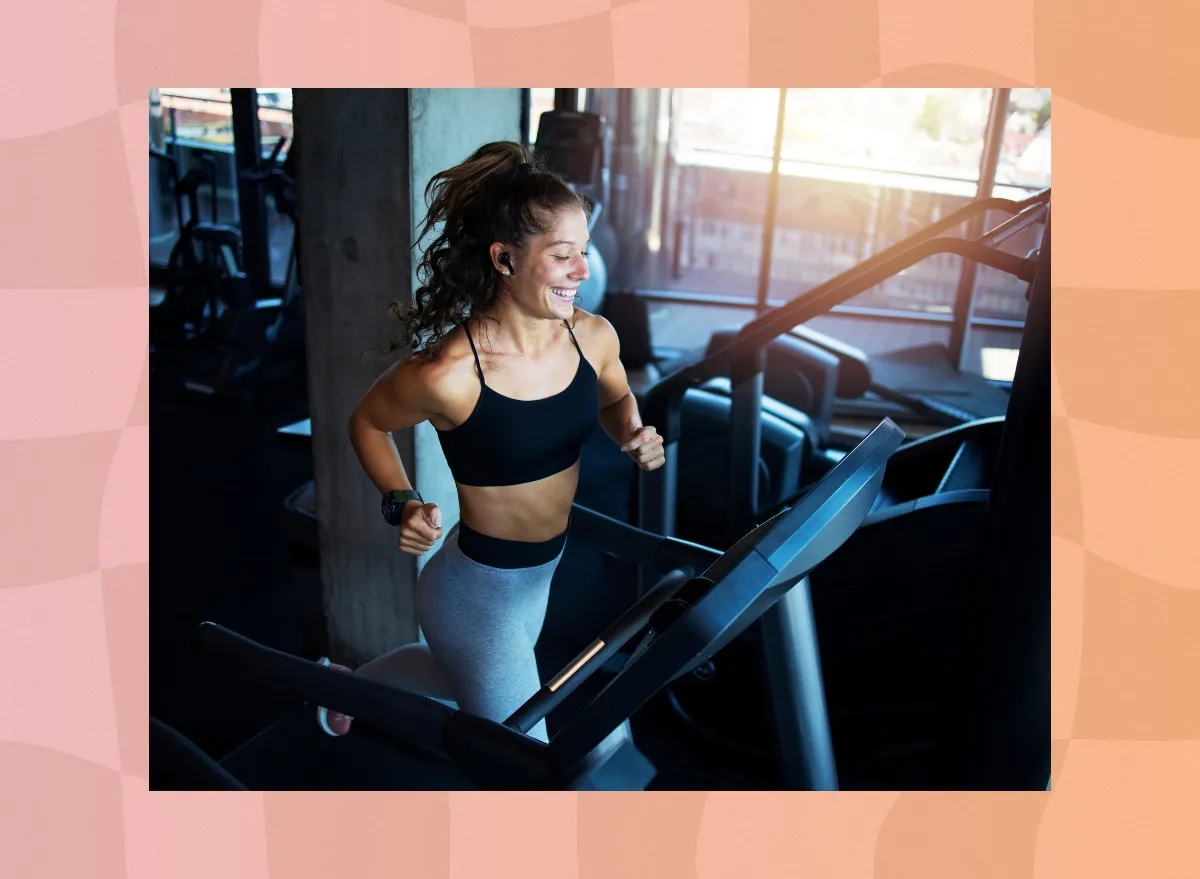The treadmill and rowing machine offer many benefits for weight loss, yet the question begs, “Treadmill or rowing machine: which is more effective for weight loss?”
Both the treadmill and rowing machine offer compelling reasons for consideration. Treadmills are staples in gyms and fitness studios, providing easy accessibility for users of all levels. Rowers are often found in specialized environments like CrossFit or performance gyms, catering to individuals seeking a comprehensive full-body workout.
While treadmills are straightforward to use, rowing machines require a degree of skill and technique. Treadmills primarily target the lower body and offer versatility through speed and incline adjustments, whereas rowing engages the entire body and adjusts intensity via resistance. When choosing between them for your cardio workout, consider your preferences, fitness goals, and the type of workout experience you seek.
Continue reading to compare the two pieces of equipment. By the end, you’ll have a clearer understanding of which best suits your fitness goals and preferences.
The benefits of treadmill workouts for weight loss:
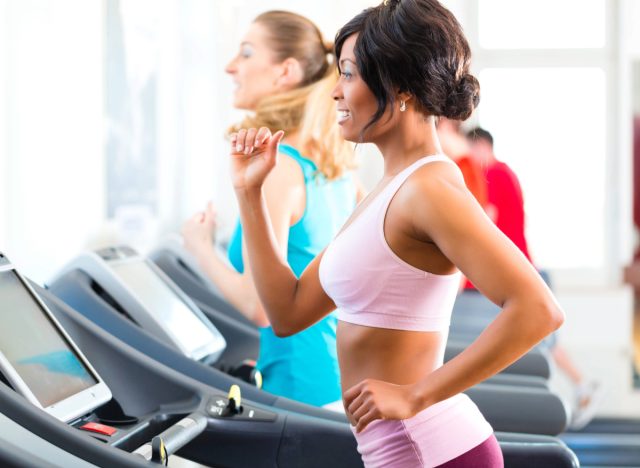

Treadmill workouts offer many advantages that make them a top choice for those seeking to slim down, whether at home or in the gym. The beauty of these workouts lies not only in their metabolic impact but also in their versatility, offering a range of options from heart-pumping sprints to challenging hill climbs or even leisurely steady-state runs or intervals, all at your convenience.
Here are the key factors that make treadmill workouts beneficial:
- They help you burn calories. Treadmill workouts allow you to burn a significant amount of calories in a relatively short period, depending on factors like speed, incline, and duration—enhancing weight loss and efficiency. The more intense the workout, the more calories you’ll burn.
- They’re easily customizable. One of the standout features of treadmill workouts is their adaptability. Treadmills offer adjustable speed and incline settings, empowering you to tailor your workout intensity to your fitness level and goals. Whether you’re a beginner or a seasoned athlete, you can increase the speed or incline to amp up calorie expenditure and challenge your cardiovascular system, all in the pursuit of weight loss.
- They help you stay consistent. They provide a consistent and controlled environment for exercising. You can maintain your workouts regardless of weather conditions or time of day, making it easier to stick to your routine.
- They offer a variety of workouts to choose from. Gear up for interval training, hill climbs, and endurance runs. This variety helps prevent boredom and keeps your workouts engaging, encouraging adherence to your weight-loss regimen. Want to take it to another level? Toss a weighted vest on to up the ante.
The benefits of rowing machine workouts for weight loss:
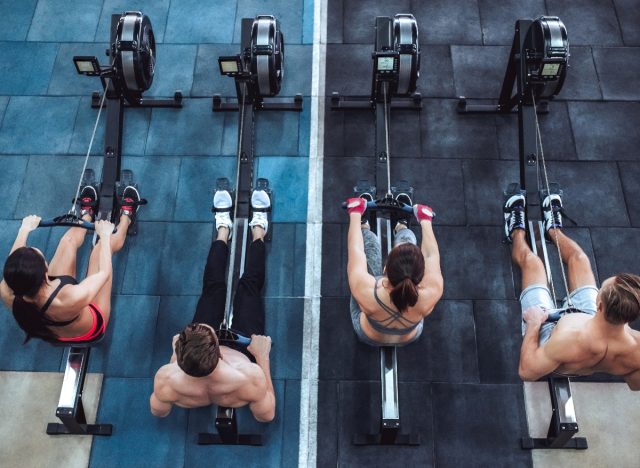

Rowing machines stand out for offering a full-body workout, unlike traditional cardio machines. With each stroke, the rower engages your legs in the drive phase and activates your upper body and core as you complete the pull phase. This dual-action targets multiple muscle groups simultaneously, making it an efficient exercise option for overall fitness.
What sets the rower apart is its emphasis on technique and skill development, a unique aspect compared to other cardio machines. Mastering efficient rowing techniques requires dedication and practice, offering a fresh perspective on weight-loss workouts. As you hone your skills on the rower, you burn calories and enhance your coordination, balance, and muscular endurance, leading to more effective and rewarding fitness results.
Here are the key factors that make rowing machine workouts beneficial:
- They boost your metabolism and torch calories. Rowing engages multiple muscle groups simultaneously, making it a highly efficient calorie-burning exercise. A vigorous rowing session can burn a significant amount of calories in a short time, aiding weight loss.
- They provide an excellent full-body workout. Rowing targets various muscle groups, including the legs, core, back, arms, and shoulders. This full-body engagement helps build lean muscle mass while burning fat, leading to overall weight loss and sculpting.
- They’re low-impact on the joints. Rowing is a low-impact exercise, meaning it puts minimal stress on the joints compared to activities like running or jumping. This makes it suitable for individuals with joint issues or those recovering from injuries, allowing for consistent workouts without risking further injury.
- They offer versatile workout intensity and duration. Whether you’re looking for a high-intensity interval training (HIIT) session or a steady-state cardio workout, rowing machines can accommodate various fitness levels and goals, making them suitable for individuals at different stages of their weight-loss journey. You can easily adjust the intensity by modifying the resistance level via the damper, allowing you to customize your workout routine to fit your fitness level and goals.
RELATED: The 30-Day Treadmill Workout Plan To Melt Belly Fat
Which is most effective for weight loss?
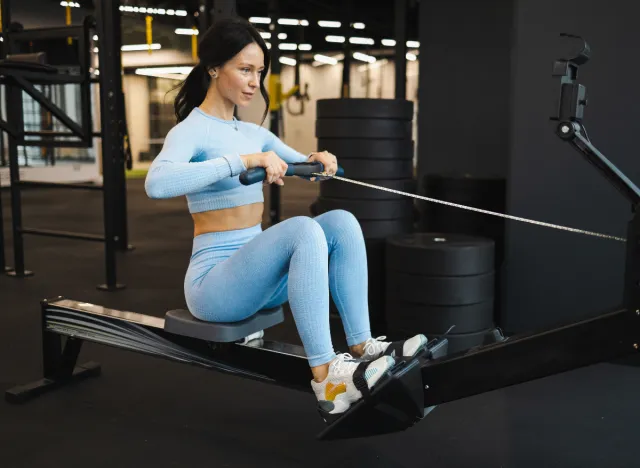

I side with the rowing machine because it provides a more effective weight-loss workout with more options than the treadmill. The big selling point? The rowing machine offers a full-body session, engaging both the lower and upper body to stimulate a metabolic effect for weight loss.
Ultimately, it comes down to your personal preference, and as a fitness coach, I’m just happy you’re working out! Regardless, here’s a quick breakdown of the comparison between the treadmill and rowing machine.
- Metabolism effect: Both treadmill and rowing machine workouts can burn a significant amount of calories. Treadmill workouts primarily focus on cardiovascular exercise, while rowing engages cardiovascular and muscular systems. The calorie burn depends on factors such as intensity, duration, and fitness level.
- Muscle engagement: Rowing machines provide a full-body workout, engaging multiple muscle groups, including the legs, core, back, arms, and shoulders. Treadmill workouts mainly target the lower body muscles, particularly the quadriceps, hamstrings, and calves. Rowing may be more effective if you’re looking for a workout that engages more muscle groups.
- Impact on joints: Treadmill workouts involve repetitive impact on the joints—especially if running or jogging at high speeds. This may not be suitable for individuals with joint issues or injuries. Rowing, on the other hand, is a low-impact exercise, making it gentler on the joints and suitable for a wider range of individuals.
- Variety and enjoyment: Some people may find treadmill workouts more enjoyable—especially if they prefer running or walking outdoors. Treadmills also offer options for incline and speed variations, allowing for versatile workouts. However, others may find rowing machine workouts more engaging due to the variety of movements and the challenge of mastering proper rowing techniques.
- Skill development: Rowing requires proper technique to maximize effectiveness and prevent injury. Learning and refining rowing techniques can be a rewarding aspect of rowing machine workouts, but they may require more initial practice than treadmill workouts.
What are the best workouts for the treadmill and rower?
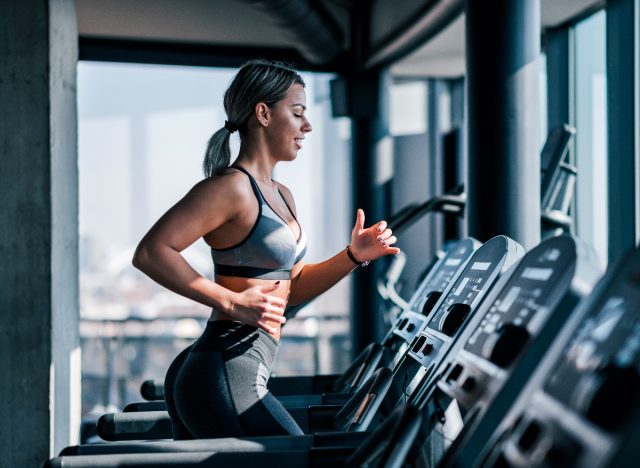

These workouts can be used interchangeably for the treadmill or rower machine. Each method is proven to be effective in upping your calorie-burning capabilities.
1. Steady-state Cardio
When it comes to cardio for weight loss, nothing beats steady-state sessions to maximize the potential effects. You’ll want to keep your heart rate between 60% and 70% for these workouts. If you don’t have a heart rate monitor, use the “conversation pace” as a guide. Keep the effort up, but stay at a pace where you can maintain a conversation with a friend.
For this workout, you have two choices: either begin with one to two sets, each lasting 15 to 20 minutes of continuous movement, or opt for a single round lasting 30 to 45 minutes. As you progress, aim to increase the total distance covered or the duration of your workout. Additionally, consider elevating the challenge by adjusting the treadmill’s incline or increasing the rowing machine’s resistance during subsequent sessions.
These incremental adjustments will help push your limits and enhance the effectiveness of your workouts, contributing to your overall fitness and weight-loss goals.
2. Cardio Intervals
Knocking out a cardio workout for weight loss using intervals keeps your workouts fun and effective. Working with shorter durations and minimal rest allows you to spice up your routine while harnessing the positive effects of the treadmill or rower machine for weight-loss workouts.
To maximize the effectiveness of this workout, aim to complete one to two sets, each comprising eight to 12 rounds. During each round, engage in two minutes of movement at a moderate pace, pushing yourself but maintaining control. Following the movement interval, allow yourself a one-minute rest period, during which you should reduce the intensity to a low to low-moderate level. This contrast between active and rest periods elevates your heart rate while providing brief recovery windows.
Between sets, take a longer rest of two to three minutes to fully recover before tackling the next set. This structured approach optimizes calorie burning and muscle engagement, contributing to your weight-loss goals while ensuring proper recovery to prevent overexertion.

